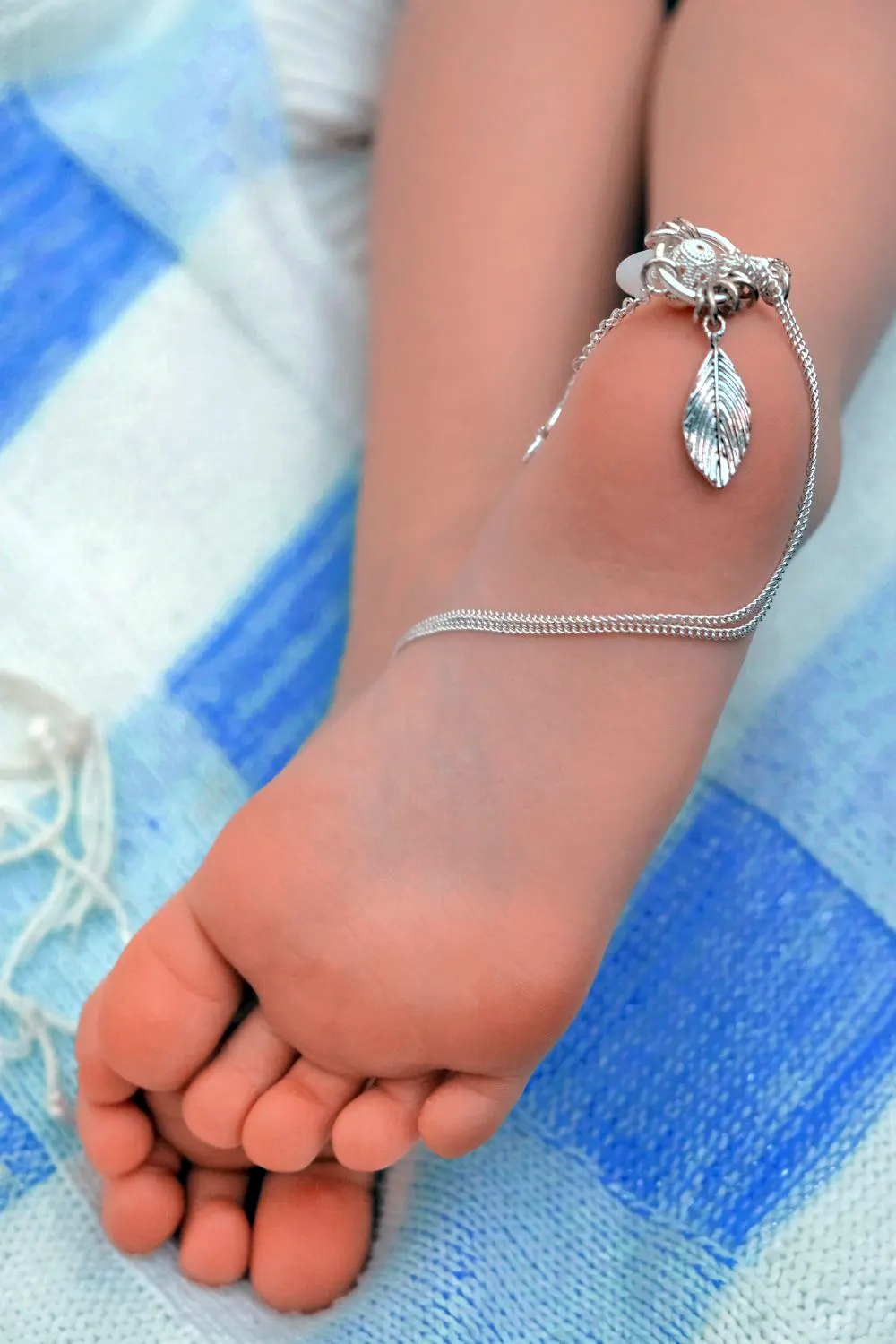Anklets have been worn for ages, carrying various symbolic meanings across cultures. The tinkling anklets have attracted lovers and speak of beauty, protection, and traditions.
Anklets signify marriage when worn by married women, especially in South Asia. There, grooms gift anklets to brides as a wedding gift, showing their marital status. Anklets are also seen as a symbol of fertility, as the ankle is near the womb, and the sound attracts husbands.
Anklets also protect women, warding off evil spirits as the tinkling confuses them. They can show social status, as only wealthy women wore gold and silver anklets in ancient Egypt. Today, anklets simply add elegance or fashion to an outfit, expressing one’s style.
The symbolic meaning differs for each wearer. There is no right or wrong answer, and symbolism varies for each person. In India, married women wear anklets to attract husbands. In Africa, anklets symbolize fertility. In South America, anklets protect against evil. In ancient Greece, anklets showed women’s beauty and sexuality. In ancient Rome, both men and women wore anklets as a symbol of wealth.
The symbolic meaning of anklets varies across cultures. But generally, anklets represent beauty, fertility, protection, and status, apart from simply adding elegance to an outfit. Let’s dive into more detail.
What does wearing an anklet mean?
Marriage symbol
Wearing an anklet can signify a woman’s marital status in some cultures.
With its tinkling sounds, an anklet can announce to the world that a woman is married. In many parts of South Asia and Africa, married women traditionally wear anklets given to them by their husbands. The anklet takes on a symbolic meaning, showing the wife has a partner and provider.
But the anklet also has implications within the marriage itself. The sound of the bells is thought to attract the husband and keep him close. The notion arises from a view of the ankle as representing the womb and fertility. An anklet can help ensure a spouse’s attention and good fortune in childbearing.
Different types of anklets denote different marital milestones. In some places, simple metal anklets are worn after engagements, while beaded or stone anklets signify an official wedding. Anklets may also change over time, adopting more decorative features as a marriage progresses.
Overall, the core implication remains that when a woman wears an anklet, she has a husband. The anklet thus shows her family and community that she is rightfully spoken for. The bells announce that she has a partner and protector to meet her needs. The ankle jewelry broadcasts that she is a married woman.
The symbolic meaning of an anklet as a sign of marriage varies by culture. But in many places, the tradition remains that an anklet marks a woman as somebody’s wife.

Fertility charm
Wearing an anklet can signify fertility and blessings for conceiving in some cultures.
In certain places, anklets are seen as fertility charms meant to attract a husband and help women conceive. The ankle represents the womb, so an anklet worn there takes on symbolic meanings related to fertility and childbearing.
Anklets made with specific materials believed to aid fertility are often worn for this purpose. In India, silver anklets are seen as helpful for regulating a woman’s cycle. In Africa, anklets of beads or shells represent a woman’s fertility. The sounds also attract husbands believed vital for conceiving.
Different types of anklets can indicate a woman’s fertility goals. In some African cultures, women trying to conceive often wear bead anklets. The beads symbolize the woman’s fertility, and the sounds attract husbands to have children.
Historically, anklets symbolized fertility. In ancient Greece, anklets helped women conceive and deliver healthy babies. In Rome, both men and women wore anklets as fertility symbols for easy conception and healthy offspring.
Many cultures view the anklet around the ankle – representing the womb – as a fertility charm. The bells attract the husband and symbolize the woman’s childbearing abilities. Anklets made with materials meant to aid fertility, and types of anklets indicating a desire for children, show this symbolic meaning of anklets related to conceiving and giving birth.
Protection talisman
Wearing an anklet can signify the desire for protection in some cultures.
In certain places, anklets provide more than just an ornamental function; they act as powerful protection talismans believed to ward off evil spirits and negative energies. The ankle, being vulnerable, requires safeguarding via the anklet.
Anklets made with materials thought to possess protective powers are often worn for this purpose. In India, copper anklets are believed to have warding-off properties that guard against evil spirits. In Africa, bead anklets represent protection, and the sounds confuse evil spirits, keeping them away.
The type of anklet worn indicates the wearer’s need for protection in some cultures. Bead anklets, worn by traveling African women, symbolize protection through their representation and sounds.
Historically, anklets protected women. In ancient Greece, anklets shielded women from evil spirits and ensured their safety. In Rome, anklets worn by both sexes protected against evil spirits and provided security.
The ankle – a vulnerable body part – requires safeguarding in the view of many cultures. The anklet around the ankle then takes on symbolic meanings related to protection, luck, and warding off evil. Anklets made of materials believed to possess protective powers and types that indicate the desire for protection show this meaning related to shielding the wearer from harm.
Status indicator
Wearing an anklet can signify social status and wealth in some cultures.
Historically, anklets served as status symbols, whereas elaborate gold or silver anklets showed high standing. In some African tribes today, anklets worn during ceremonies signify status and fortune.
Only the privileged could afford expensive anklet materials, showing off their wealth and status. The ankle symbolizes power and control, so the anklet reinforces this.
- In African tribes, anklet type and material denote status. Only chiefs or high ranks wear gold or silver anklets, indicating their position.
- Ancient Egypt: Only the wealthy wore gold or silver anklets as status symbols. Elaborate designs showcased wealth.
- India: Gold or silver anklets still signify status, where elaborate designs make fashion statements of wealth.
- Africa: Anklets worn during ceremonies signify status and fortune based on material and type.
Anklets have long signified status and wealth through expensive materials and elaborate designs that showcase fortune. The ankle, a symbol of power, elevates a wearer’s standing when adorned with an ornate anklet. Anklets indicate status through material and design, and who is allowed to wear them shows this symbolic meaning related to social standing.
Fashion accessory
Wearing an anklet can signify fashion sense and style.
Beyond symbolism, anklets primarily serve as trendy fashion accessories that add flair to any outfit. They exude elegance and charm, elevating simple looks into statement pieces.
Anklets come in varied styles, materials, and hues, ensuring one complements any ensemble. Whether delicate or ornate, anklets match any attire, from casual to formal. They pair well with shorts, skirts, dresses, jeans, sandals, heels, and flip-flops.
Anklets reflect an individual’s fashion tastes and flair for personal style. Choosing complementary anklets aligns with an outfit’s formality. Dainty anklets suit casual styles, while ornate anklets elevate structured looks. Opt for metallic or beaded anklets harmonizing with other accessories. Experimenting with multiple anklet combinations exhibits creativity.
Mixing anklets showcases personality. Gold and silver anklets glam up basic ensembles. Beaded anklets add bohemian flair. Anklets fashioned from coins or charms infuse whimsy. Worn singly or stacked, anklets elevate the style.
Anklets primarily function as trendsetting accessories that enhance fashion and highlight personal aesthetics. When selected carefully and worn imaginatively, anklets transform simple looks into stylish ensembles that exhibit personality, creativity, and unique flair. Anklets symbolize more than cultural significance – they epitomize subtle yet noteworthy statements of individuality and style.

Spiritual connection
Wearing an anklet can signify one’s spiritual connection in some cultures.
Anklets represent more than mere adornment in certain places; they symbolize a link to higher realms of angels and spirits. The ankle acts as a portal, so the anklet worn there connects the wearer to spiritual energies for cleansing and positivity. The sounds also attract these energies.
Anklets made with materials thought to aid spirituality are worn for this purpose. Silver anklets purify a wearer’s energy field in India through their cleansing properties. In Africa, bead anklets represent one’s connection to the spiritual realm.
The type of anklet indicates the wearer’s spiritual beliefs in some cultures. Bead anklets, worn by African women involved in spiritual practices, represent their spiritual connection.
Historically, anklets symbolized a connection to divine beings. In ancient Greece, anklets linked women to Aphrodite, the goddess of love. In Rome, anklets connected wearers to Mercury, the god of travel and communication.
The ankle – seen as a spiritual portal – takes on symbolic meaning when adorned with an anklet. The sounds purify and link the wearer to angels and deities for spiritual cleansing and positivity. Anklets made of materials believed to aid spirituality, and types indicating spiritual practices, show this meaning related to connecting with higher powers.
Wealth attraction
Wearing an anklet can signify the desire to attract wealth and prosperity.
The anklet’s symbolism extends beyond aesthetics; it represents abundance and good fortune, attracting wealth into one’s life. Anklets signify tokens of wealth, fortune, and financial success.
Ancient Egyptians wore gold anklets as status symbols showcasing abundance. Indians wear precious metal and gemstone anklets believed to protect and bring prosperity. In Greece, brides wore anklets, ensuring happy, wealthy marriages.
Certain materials in anklets traditionally attract wealth:
- Gold – A symbol of wealth, prosperity, and good luck
- Silver – Associated with abundance and protection
- Gemstones like citrine, amber, and jade – Said to promote fortune, prosperity, and abundance.
An anklet with designs symbolic of wealth and prosperity, like lotus flowers or dragons, may attract material gain.
In summary, anklets bear symbolic meanings related to accumulating riches. Whether simply ornamental or made with inherently ‘prosperous’ materials and designs, anklets represent treasures and financial success, signifying the wearer’s desire to bring abundance into their life. Anklets worn accordingly become tokens intended to actualize fortunes.
Friendship bond
Wearing matching anklets can signify a friendship bond.
Anklets signify more than individual style; they indicate friendship and camaraderie. Friends wear corresponding anklets to strengthen connections and show care.
Matching anklets show friends share deep connections and special moments. Friends don matching anklets to celebrate anniversaries, commemorate trips together and honor closeness.
Anklets come in varied materials. Metallic, beaded, or shell anklets can sport symbols like hearts, stars, or initials reflecting friendships. Designs chosen represent bonds between friends.
Donning matching anklets exhibits friendships. The anklets demonstrate friends’ value and rely upon each other. They symbolize closeness and companionship between wearers.
Tips for choosing matching anklets:
- Select designs echoing friendships, like team emblems for fans
- Opt for durable, comfortable materials
- Pick shared favorite hues for cohesive looks
- Consider occasions like graduations for ornate styles
In conclusion, corresponding anklets signify more than individual styles; they represent friendship symbols. The anklets demonstrate affection, care, and camaraderie between wearers, broadcasting their close friendship bond.
Relationship sign
Wearing an anklet can signify one’s relationship status.
Traditionally, anklets represented love and commitment as a romantic gesture from grooms to brides. Today, anklet placement hints at availability in subtle ways.
Left ankle – Adorning this heart-aligned side in some cultures signifies singleness, showing the wearer’s openness to relationships.
Right ankle – Some cultures view decorating the sun-associated side as representing a committed status, reflecting exclusivity to a partner.
While ankle placement meanings vary across cultures, anklets can subtly tip suitors off. Wearing one on the left may indicate availability, while donning one on the right may signal being spoken for.
However, ask the wearer to ensure the meaning as cultural interpretations differ. Anklets alone cannot conclusively reveal relationship status.
Although originally signifying love within marriages, anklets now subtly indicate availability through placement relative to the heart and sun. Specific positioning according to cultural norms expresses wearers’ relationship status by denoting singleness or taken qualities. While anklets may hint, directly communicating with individuals avoids misleading interpretations as symbolic meanings vary greatly.

Summary
Anklets, with their tinkling allure, carry various symbolic meanings across cultures. They signify marriage, fertility, protection, status, and fashion. Anklets may indicate spiritual connections and attract wealth. Wearing matching anklets can represent strong friendship bonds.
Additionally, the placement of anklets hints at one’s relationship status, subtly signaling availability or commitment. While the symbolic meaning varies across cultures, anklets are cherished for their beauty and personal expressions.
FAQ
Do anklets have a hidden meaning?
Yes, anklets can have hidden or multiple meanings depending on the culture and context. For example, in some cultures, wearing an anklet on the right ankle can indicate that the wearer is single or looking for someone to marry, while wearing an anklet on the left ankle can indicate that the wearer is married. There are also specific subcultures with specific meanings, such as the hotwife anklet being a discreet sign that a woman can date other men with her husband’s permission and approval.
What does an anklet mean in old times?
Anklets have been worn for centuries, and their meaning has evolved over time and varied across different cultures. In ancient times, both men and women wore anklets for various reasons, such as indicating social status, marital status, or as a fashion accessory. In ancient Egypt, anklets symbolized wealth and marital status, and both men and women wore them. During the Indian Vedic period, wearing anklets was a sign of a woman’s marital status and was considered an essential part of women’s jewelry.
What does one leg black thread anklet mean?
Wearing a black thread anklet around one’s leg is believed to have various benefits, particularly in warding off negative energy or evil eye targeted at the wearer, with the black thread serving as protection from such energies. Some believe that wearing a black thread anklet on the left ankle can offer protection to women, while others believe that wearing it on the right ankle can offer protection for men. Additionally, according to Hindu astrology, some believe that wearing a black thread anklet around the ankle can make Lord Shani the guide and protector of the wearer.
What does infinity anklet mean?
An infinity anklet symbolizes eternity, empowerment, everlasting love, and undying commitment. An infinity symbol can also express undying love for someone or something, such as love between friends, family members, or soulmates. In some subcultures, an infinity anklet also has more specific meanings, such as indicating a commitment to a polyamorous relationship or indicating a wife’s commitment to her husband while also being open to dating other men.
What does a red string anklet mean?
Wearing a red string anklet symbolizes spiritual protection, good luck, and warding off negative energy. In ancient Chinese legend, a “Red String of Fate” ties together people who are destined to meet and helps them find each other. Red string bracelets are often worn as a symbol of this legend and to bring good luck and fortune. The red string is associated with various spiritual practices and is believed to ward off negative energy and provide protection.



